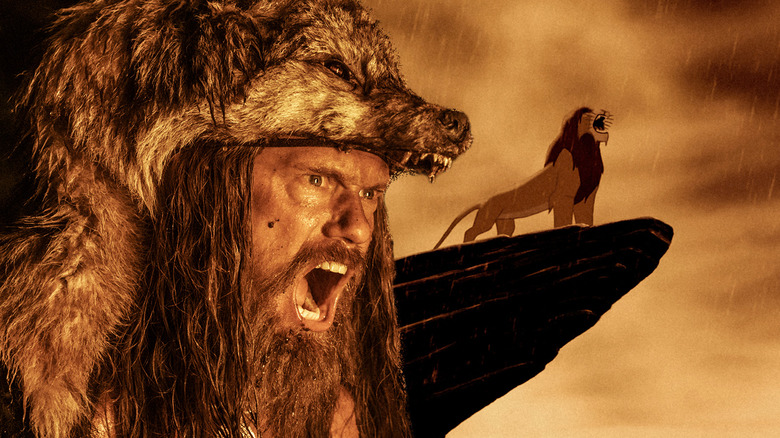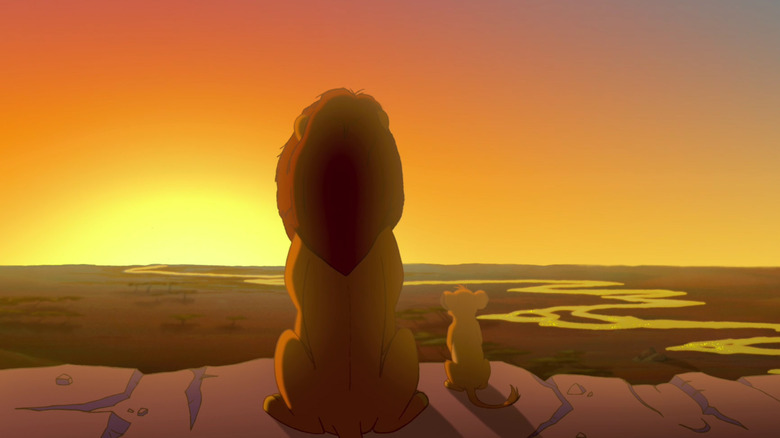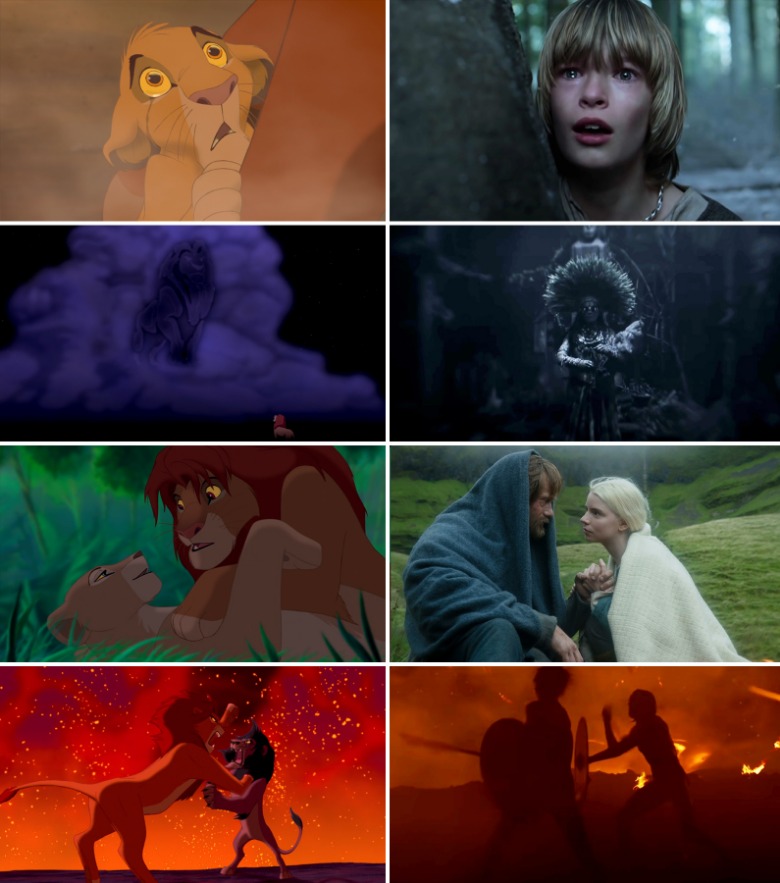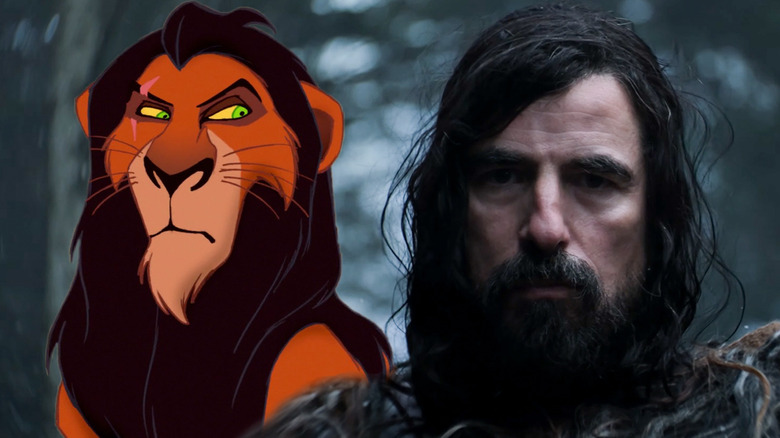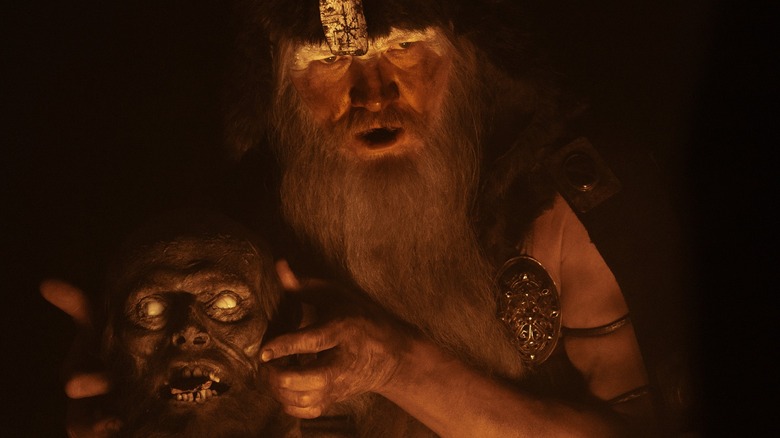Why The Northman Has The Same Plot As The Lion King
Warning: spoilers ahead for "The Northman" (and also for "The Lion King" and "Hamlet").
First appearing in Saxo Grammaticus's Gesta Danorum, "Deeds of Danes," the story of Amleth has been told and retold since the early 13th century — and has now been brought to the big screen in Robert Eggers' direct adaptation, "The Northman." Over the years, the story has evolved like a weird game of medieval telephone, but for the most part, the heart is the same.
The young prince Amleth witnesses his uncle brutally murdering his father in an act of jealousy. The uncle then kidnaps the boy's mother and destroys their village. Amleth flees, (pleading insanity in most cases) and returns years later, after he has become a powerful Viking. Upon meeting a Seeress who reminds him of a vow he made in his younger years, Amleth decides to save his mother, kill his uncle, and avenge his fallen father. Obviously there have been some massive creative liberties taken in the 800+ years since the mythos first appeared, but this is roughly what we're working with.
If this sounds a lot like the plot of the play "Hamlet," it's because it is the plot of "Hamlet." William Shakespeare was so inspired by the Norse tale that he wanted to provide his own take on the story, moving the "H" in "Amleth" to the front of his name and thereby creating "Hamlet." It's believed that Willy Shakes never actually had the chance to read the text for himself, having only learned the tale through word of mouth retelling and crude translations.
As we all know (or should know), "The Lion King" was Disney's attempt at making "Hamlet" for kids, so ipso facto, "The Lion King" is "The Northman" and "The Northman" is "The Lion King."
The story of The Northman and The Lion King
The story of Amleth may predate both "Hamlet" and "The Lion King," but given the cultural dominance of both Shakespeare's work and the animated Disney musical featuring Nathan Lane as a singing meerkat, "The Northman" definitely feels like a film that exists in a post-"Lion King" world.
The young version of Amleth (Oscar Novak) is an echo of young Simba (Jonathan Taylor Thomas): a prince who idolizes his father, the king (Ethan Hawke as King Aurvandil War-Raven/James Earl Jones as Mufasa). Unfortunately, his uncle (Jeremy Irons' Scar/Claes Bang's Fjölnir the Brotherless) kills the king and takes the queen (Madge Sinclair as Sarabi/Nicole Kidman as Queen Gudrún) as his own wife.
In both stories, due to the uncle coming to power through fratricide, the reign is cursed. Scar's rule over the Pride Lands brings drought and famine, while Fjölnir quickly loses his kingdom and flees to the harsh new home of Iceland, where he's forced to lead the humble life of a sheep farmer. Amleth and Simba are shown as being impulsive, fueled by rage and revenge, but eventually learn to let go of that anger and be the bigger person, valuing their love for their kin over their anger.
In "The Northman," Amleth chooses to give up on his quest to murder his uncle and leave Iceland with Olga — returning only after he learns that Olga is pregnant, because he fears that Fjölnir will hunt down his children and murder them the same way he murdered Amleth's father. In "The Lion King," Simba fights his uncle furiously but ultimately tries to save Scar's life at the end of their final battle. "The Northman" obviously characterizes all of these situations in a far more brutal and unflinching manner than "The Lion King," but the heart of the stories is the same.
The Northman's characters and their Lion King counterparts
The character parallels between "The Northman" and "The Lion King" are not limited to the royal family. In "The Lion King," Simba encounters a mandrill named Rafiki who serves as a shaman and the Royal Mjuzi of the Pride Lands. He comes across a little odd, but is a wise sage with a deep connection to the magical and spiritual worlds.
In "The Northman," this role is broken apart into three separate individuals: King Aurvandil's court jester and spiritual guide, Heimir the Fool (Willem Dafoe); the Seeress (Björk), an eerie figure who appears in a temple that Amleth's berserker party burned to the ground; and a strange figure called the He-Witch (Ingvar Sigurdsson), whom Amleth meets after journeying to Iceland.
While Amleth is exiled from his home, he is taken in by a group of Vikings known as the berserkers, who are possessed by animal spirits and are basically a really, really, ridiculously violent analog of Timon and Pumbaa in "The Lion King." Of course, it couldn't be a hero's story without a love story, and Amleth eventually falls in love with the Slavic sorceress Olga of the Birch Forest (Anya Taylor-Joy), in the same way Simba falls in love with Nala (Moira Kelly), and Hamlet with Ophelia.
Oh, I just can't wait to be (Vi)king!
With "The Lion King" being for children, a lot of the more ferocious aspects of the stories were understandably sugarcoated for younger audiences. Eggers has spoken at length about how he intentionally made "The Northman" as a way to bring back the savage nature of the Vikings. When people think of Vikings, he explained, "they think cartoon guys with horn helmets or certain TV shows where Vikings dress like science-fiction rock stars," he said. "This is something very different."
The film also folds in story elements from "Hamlet," the best-known retelling of Amleth's story. In one of the most prominent examples of this, Willem Dafoe's Heimir the Fool becomes an echo of one of Shakespeare's most iconic dead guys: poor, poor Yorick. Heimir is beheaded when Fjölnir purges his new kingdom of Aurvandil's allies, but he "returns" later when the He-Witch reveals that he has kept Heimir's severed head and "restored" the eyes and tongue that Fjölnir ripped out. It's gross, it's awesome, and it's creepy as hell.
Though "save mother" is initially an important part of Amleth's mantra, that changes after Queen Gudrún gleefully confesses that she begged Fjölnir to murder her first husband, and willingly became Fjölnir's queen afterwards. Amleth eventually kills his mother and half-brother, Gunnar, in a moment that echoes the deaths of Gertrude and Laertes in the final scene of "Hamlet." In Shakespeare's play, Hamlet isn't responsible for these deaths; Laertes dies by his own poison-tipped sword, and Gertrude drinks a poisoned cup intended for her son. Though his role is more direct, Amleth kills both Gudrún and Gunnar in self-defense and greatly regrets it, mourning their deaths and forgiving his mother for her actions before he and his uncle battle to their own mutual deaths.
Obviously comparing a high-concept, R-rated film like "The Northman" to a family friendly animated musical is a bit like comparing apples to oranges, but it's a testament to the tale of Amleth/Hamlet/Simba as one of the quintessential examples of "the hero's journey." The story is easy to digest and comprehend, and can appeal to a variety of ages — regardless of whether or not we're dealing with Norse Vikings or adorable creatures on the plains of Africa. Themes of revenge, corruption, spirituality, politics, perception vs. reality, and the influence of love and pain have been present for over eight centuries, and if the positive reviews of "The Northman" are any indicator, these are themes that will continue to resonate for many more years to come.
